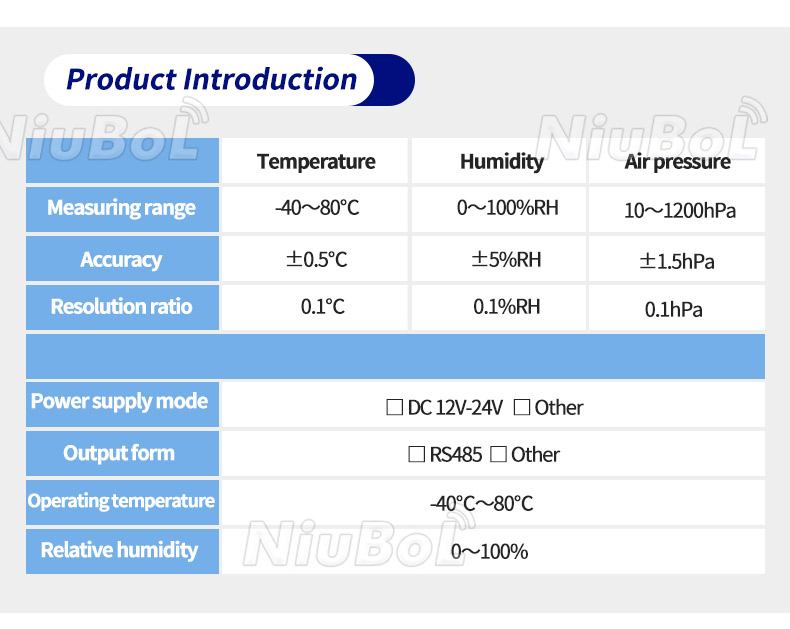

— Blogs —
—Products—
 Consumer hotline +8618073152920
Consumer hotline +8618073152920 WhatsApp:+8615367865107
Address:Room 102, District D, Houhu Industrial Park, Yuelu District, Changsha City, Hunan Province, China
Product knowledge
Time:2024-01-01 12:19:08 Popularity:2792
Rain sensor and humidity sensor detailed description:
1. Rain Sensor (Rain Gauge):
A rain sensor is a sensor used to measure the amount of precipitation. It usually consists of a water catchment container and a recording device. When precipitation occurs, raindrops fall into the catchment vessel, which is designed to ensure accurate collection of raindrops and avoid evaporation. The recording device records and displays the amount of precipitation collected and can be either digital or analog pointer type.

There are several types of rain sensors that operate, including mechanical, photoelectric and ultrasonic. Common mechanical rain sensors use a funnel shaped catchment container that tilts when a certain amount of rainwater is collected, causing the recording device to record this amount. Photoelectric rain sensors use a light beam to detect the fall of rainfall droplets and calculate the amount of precipitation based on how long the light beam is blocked. Ultrasonic rain sensors, on the other hand, use the reflection of ultrasonic waves to measure the amount of precipitation.
The main application of rain sensors in smart agriculture is to help farmers understand the local precipitation situation in order to develop appropriate irrigation plans and crop management strategies.
2. Moisture Sensor (Humidity Sensor):
Moisture sensor is a sensor that measures the humidity of air. It measures the amount of water vapor in the air and expresses it in the form of relative humidity (RH). RH is the ratio between the water vapor content of the air and the saturated water vapor content.
The operating principle of humidity sensors is usually based on the principles of capacitance, resistance or conductivity. Among others, capacitive humidity sensors utilize the effect of moisture in the air on the capacitance to measure humidity. Resistive humidity sensors, on the other hand, measure humidity based on the change in resistance of a material as a function of humidity. Conductivity humidity sensors calculate humidity values by measuring the effect of humidity on the conductivity of a material.

The application of humidity sensors in smart agriculture is very important. Humidity is one of the key environmental parameters for crop growth and development. By monitoring humidity, farmers can adjust irrigation strategies, control greenhouse ventilation and cooling to ensure that crops are grown in appropriate humidity conditions and avoid problems caused by too high or too low humidity.
To summarize, rainfall sensors are used to measure the amount of precipitation, while humidity sensors are used to measure the amount of moisture in the air. Their use in smart agriculture helps farmers in precise agricultural management and regulation to improve crop yield and quality.
What is the difference between a rain sensor and a moisture sensor?
A rain sensor and a moisture sensor are two different types of sensors, and the main difference between them lies in the measurement parameters and applications.
Rainfall sensors are mainly used to measure the amount of rainfall, which can detect the landing and accumulation of rainwater per unit area, usually used in meteorology, agriculture, urban drainage and other fields.
While humidity sensors are mainly used to measure the humidity in the air, that is, the amount of water vapor in the air, usually used to regulate air humidity, control the production environment and detect the humidity of warehouses and so on.
In terms of application, rainfall sensors are mainly used for measuring and recording rainfall in the fields of meteorological monitoring, flood early warning, urban drainage, etc., which help people to understand the rainfall situation, predict natural disasters such as floods, and take corresponding measures.
While humidity sensors are widely used in air conditioning, dryers, bakehouses, warehouses and other fields, for detecting and controlling the environmental humidity, to ensure the drying and preservation of items, and to improve production efficiency and product quality.
In conclusion, although both rainfall sensors and humidity sensors are sensors used to measure moisture, they have different measurement parameters and application areas. Rainfall sensors are mainly used to measure the amount of rainfall, while humidity sensors are mainly used to measure the humidity in the air.
Agriculture-Sensors-Weather-Stations-Catalog-NiuBoL-New.pdf
Related recommendations
Sensors & Weather Stations Catalog
Agriculture Sensors and Weather Stations Catalog-NiuBoL.pdf
Weather Stations Catalog-NiuBoL.pdf
Related products
 Combined air temperature and relative humidity sensor
Combined air temperature and relative humidity sensor Soil Moisture Temperature sensor for irrigation
Soil Moisture Temperature sensor for irrigation Soil pH sensor RS485 soil Testing instrument soil ph meter for agriculture
Soil pH sensor RS485 soil Testing instrument soil ph meter for agriculture Wind Speed sensor Output Modbus/RS485/Analog/0-5V/4-20mA
Wind Speed sensor Output Modbus/RS485/Analog/0-5V/4-20mA Tipping bucket rain gauge for weather monitoring auto rainfall sensor RS485/Outdoor/stainless steel
Tipping bucket rain gauge for weather monitoring auto rainfall sensor RS485/Outdoor/stainless steel Pyranometer Solar Radiation Sensor 4-20mA/RS485
Pyranometer Solar Radiation Sensor 4-20mA/RS485
Screenshot, WhatsApp to identify the QR code
WhatsApp number:+8615367865107
(Click on WhatsApp to copy and add friends)
